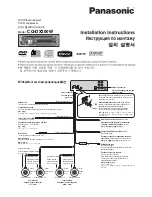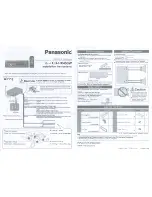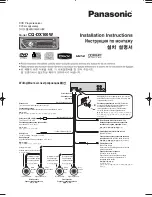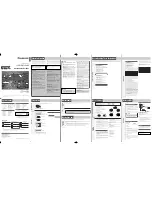
Kramer Electronics Ltd.
KIT-400
– Protocol 3000
81
Function
Description
Syntax
Parameters/Attributes
Example
NAME
Set machine (DNS)
name.
The machine name
is not the same as the
model name. The
machine name is used
to identify a specific
machine or a network in
use (with DNS feature
on).
COMMAND
#NAME
machine_name
<CR>
FEEDBACK
~nn@NAME
machine_name
<CR><LF>
machine_name
– String of up to 15
alpha-numeric chars (can include
hyphen, not at the beginning or end)
Set the DNS name of the
device to room-442:
#NAME
room-442
<CR>
NAME?
Get machine (DNS)
name.
The machine name
is not the same as the
model name. The
machine name is used
to identify a specific
machine or a network in
use (with DNS feature
on).
COMMAND
#NAME?
<CR>
FEEDBACK
~nn@NAME
machine_name
<CR><LF>
machine_name
– String of up to 15
alpha-numeric chars (can include
hyphen, not at the beginning or end)
Get the DNS name of the
device:
#NAME?
<CR>
NAME-RST
Reset machine (DNS)
name to factory default.
Factory default of
machine (DNS) name is
“KRAMER_” + 4 last
digits of device serial
number.
COMMAND
#NAME-RST
<CR>
FEEDBACK
~nn@NAME-RST
ok
<CR><LF>
Reset the machine name
(S/N last digits are 0102):
#NAME-
RST
kramer_0102
<CR>
NET-
CONFIG
Set a network
configuration.
Parameters
[DNS1]
and
[DNS2]
are
optional.
For Backward
compatibility, the
id
parameter can be
omitted. In this case,
the Network ID, by
default, is 0, which is
the Ethernet control
port.
If the gateway
address is not
compliant to the subnet
mask used for the host
IP, the command will
return an error. Subnet
and gateway
compliancy specified by
RFC950.
COMMAND
#NET-CONFIG
netw_id
,
net_ip
,
net_mask
,
gateway
,
[dns1]
,
[dns2
]
<CR>
FEEDBACK
~nn@NET-CONFIG
netw_id
,
net_ip
,
net_mask
,
gateway
<CR><LF>
netw_id
– Network ID–the device
network interface (if there are more
than one). Counting is 0 based,
meaning the control port is ‘0’,
additional ports are 1,2,3….
net_ip
– Network IP
net_mask
– Network mask
gateway
– Network gateway
Set the device network
parameters to IP address
192.168.113.10, net mask
255.255.0.0, and gateway
192.168.0.1:
#NET-CONFIG
0
,
192
.
168
.
113
.
10
,
255
.
255
.
0
.
0
,
1
92
.
168
.
0
.
1
<CR>
NET-
CONFIG?
Get a network
configuration.
COMMAND
#NET-CONFIG?
netw_id
<CR>
FEEDBACK
~nn@NET-CONFIG
netw_id
,
net_ip
,
net_mask
,
gateway
<CR><LF>
netw_id
– Network ID–the device
network interface (if there are more
than one). Counting is 0 based,
meaning the control port is ‘0’,
additional ports are 1,2,3….
net_ip
– Network IP
net_mask
– Network mask
gateway
– Network gateway
Get network configuration:
#NET-CONFIG?
id
<CR>
NET-DHCP
Set DHCP mode.
Only 1 is relevant
for the mode value. To
disable DHCP, the user
must configure a static
IP address for the
device.
Connecting Ethernet to
devices with DHCP
may take more time in
some networks.
To connect with a
randomly assigned IP
by DHCP, specify the
device DNS name (if
available) using the
NAME
command. You
can also get an
assigned IP by direct
connection to USB or
RS-232 protocol port, if
available.
For proper settings
consult your network
administrator.
For Backward
compatibility, the
id
parameter can be
omitted. In this case,
the Network ID, by
default, is 0, which is
the Ethernet control
port.
COMMAND
#NET-DHCP
netw_id
,
dhcp_state
<CR>
FEEDBACK
~nn@NET-DHCP
netw_id
,
dhcp_state
<CR><LF>
netw_id
– Network ID–the device
network interface (if there are more
than one). Counting is 0 based,
meaning the control port is ‘0’,
additional ports are 1,2,3….
dhcp_state
–
1
– Try to use DHCP. (If
unavailable, use the IP
address set by the factory or
the
net-ip
command).
Enable DHCP mode for port
1, if available:
#NET-DHCP
1
,
1
<CR>













































